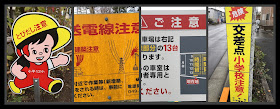A previous post discussed the Japanese penchant to display warning signs telling people to be careful (chūi =注意). Such signs (see below) can be found all over the neighbourhood. The example given previously was a small copse with a (pretty much unnecessary) sign cautioning passers-by to "be careful of the mud." Now a second sign (left) has appeared in the same place advising people to watch out for "suspicious people" (fushinsha =不審者). This time the sign is attributed not only to the municipal "water, nature, and parks" section but also the city police. The copse itself is surrounded by houses, fairly bright, with few trees.
non-Caucasian looking foreigners), are sometimes arbitrarily stopped and asked to produce their resident card which they must legally carry at all times (applies even to permanent residents). This is called shokumu shitsumon (職務質問) or police questioning. The specific law is called the Keisatsukan Shokumu Shikkō Hō (警察官職務執行法) and lets police question people "acting suspiciously" - that is, fushinsha as written on the sign. I have personally never been stopped, but many of the (decidedly non-suspicious-looking) international students in my classes have.

